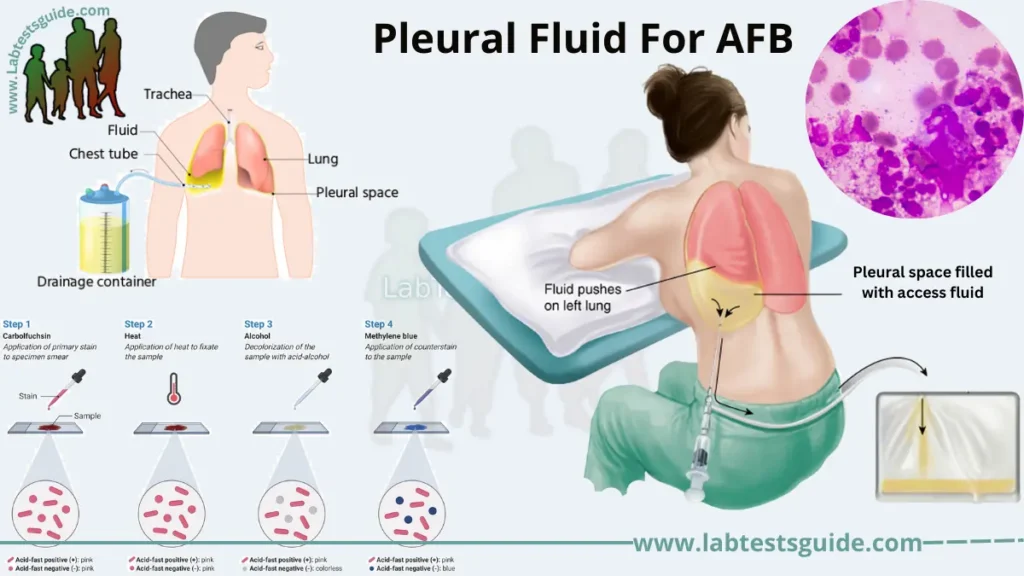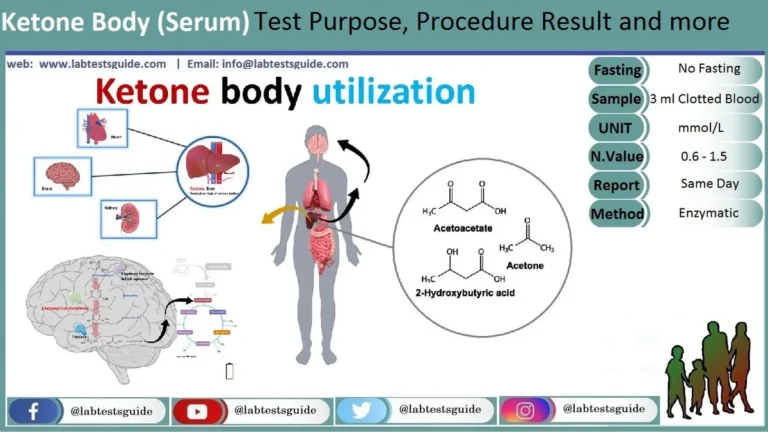Pleural fluid for AFB refers to a diagnostic test used to detect the presence of acid-fast bacilli (AFB) in the pleural fluid of a patient. The test is performed when a patient presents with pleural effusion, an accumulation of fluid in the pleural cavity surrounding the lungs, and there is a suspicion of tuberculosis or other mycobacterial infections. AFB are bacteria that can cause tuberculosis and other infections, and their presence in the pleural fluid can be an indicator of a mycobacterial infection.
Pleural fluid is a fluid that is found between the layers of the pleura. The pleura is a two-layered membrane that covers the lungs and lines the chest cavity. The area that contains pleural fluid is known as the pleural space. Normally, there is a small amount of pleural fluid in the pleural space.
| Related Articles | Sputum For AFB ZN Stain Sputum Culture MTB PCR Bronchial Washing for AFB CSF For AFB Pleural Fluid For AFB |
| Specimen | Specimen Type: Fluid Container/Tube: Sterile leak-proof container Volume: 10 mL Minimum Volume: 5 mL |
| Methods | ZN Stain, Fluorescent Microscopy, Conventional Microscopy, Auramine Stain |

Introduction and Defination:
- Introduction:
Pleural fluid for AFB test is a laboratory test used to detect the presence of acid-fast bacilli in the pleural fluid. This test is commonly used to diagnose tuberculosis infections affecting the pleura. Pleural fluid is the fluid that accumulates in the space between the lungs and the chest wall, and pleural effusion can be caused by a variety of underlying conditions, including TB. The AFB test is an important diagnostic tool for the early detection and management of TB infections. - Defination:
The Pleural Fluid for AFB Test is a diagnostic laboratory test used to detect acid-fast bacilli in the pleural fluid. This test helps in the diagnosis of tuberculosis infections affecting the pleura, and is an important tool for early detection and management of the disease.
Purpose of Pleural Fluid for AFB Test:
Here are some of the purposes of the Pleural Fluid AFB Test:
- Diagnosis of TB infection: The AFB test is an important diagnostic tool for the detection of tuberculosis infections affecting the pleura. The test helps to identify the presence of acid-fast bacilli in the pleural fluid sample, which confirms the diagnosis of TB.
- Differential diagnosis of pleural effusion: Pleural effusion can be caused by a variety of underlying conditions, including infections, cancer, heart failure, and liver disease. The AFB test helps to differentiate between infectious and non-infectious causes of pleural effusion.
- Monitoring of TB treatment: The AFB test can also be used to monitor the response of TB patients to treatment. Serial testing can help to determine whether the treatment is effective in reducing the bacterial load in the pleural fluid.
- Screening of high-risk populations: In certain populations, such as individuals with HIV/AIDS or close contacts of TB patients, the AFB test may be used as a screening tool to detect latent TB infection.
- Public health surveillance: The AFB test is an important tool for public health surveillance and tracking of TB cases in a community. It helps to identify areas with high TB burden and to implement appropriate control measures.
Why to Get Tested:
Here are some of the reasons why a patient might need to get tested for Pleural Fluid AFB:
- Presence of symptoms: If a patient presents with symptoms such as cough, fever, chest pain, and difficulty breathing, and has a history of TB exposure or risk factors for TB, they may need to be tested for TB infection, including pleural TB.
- Diagnosis of pleural effusion: If a patient has pleural effusion, the AFB test may be ordered to help diagnose the underlying cause of the effusion, including TB.
- Monitoring of TB treatment: If a patient has been diagnosed with TB and is undergoing treatment, the AFB test may be used to monitor the effectiveness of the treatment in reducing the bacterial load in the pleural fluid.
- Screening for TB infection: In certain populations, such as individuals with HIV/AIDS or close contacts of TB patients, the AFB test may be used as a screening tool to detect latent TB infection.
- Public health surveillance: The AFB test may be used as a tool for public health surveillance and tracking of TB cases in a community. This helps to identify areas with high TB burden and to implement appropriate control measures.
When to Get Tested:
- When you have signs and symptoms of a lung infection, such as a chronic cough, weight loss, fever, chills, and weakness, that may be due to TB or a nontuberculous mycobacterial (NTM) infection
- When you have a positive IGRA blood test or Tuberculin skin test (TST) and you are in a high-risk group for progressing to active TB
- When you have a skin or other body site infection that may be due to mycobacteria; when you are undergoing treatment for TB
Procedure for Collecting of Specimin:
- Patient preparation and positioning:
To prepare for pleural fluid AFB testing, the patient should sign a consent form, inform their healthcare provider of any allergies or medical conditions, and avoid blood-thinning medications if possible. During the procedure, the patient will be positioned either sitting upright or lying on their side, and the healthcare provider will clean the skin, use a local anesthetic, and collect a sample of pleural fluid using a needle. After the procedure, the patient may be advised to rest and avoid strenuous activity for a short period. - Collection Techniques:
To collect a specimen for pleural fluid AFB testing, the healthcare provider will use a sterile technique to puncture the pleural space with a needle and collect a sample of pleural fluid. The patient will be positioned either sitting upright or lying on their side with the affected side facing up, and the healthcare provider will clean the skin over the puncture site with an antiseptic solution and use a local anesthetic. After the procedure, the collected pleural fluid will be sent to a laboratory for AFB testing. - Handling and transporting the sample:
After the pleural fluid sample is collected for AFB testing, it should be handled and transported properly to ensure accurate test results. Here are some general guidelines:- Labeling: The sample should be labeled with the patient’s name, date of birth, and other relevant information.
- Storage: The sample should be kept at room temperature and protected from sunlight and heat.
- Transport: The sample should be transported to the laboratory as soon as possible to minimize the risk of sample degradation or contamination.
- Handling: The sample should be handled with care to avoid shaking or agitation that could cause hemolysis or clotting.
- Documentation: All steps of the handling and transportation process should be documented, including the time and date of collection, transport, and receipt by the laboratory.
Specimen Collection and Instructions:
Specimen Type: Pleural, Pericardial, Peritoneal, Spinal Fluid, Other Body Fluids
Container/Tube: Sterile container
Collection Instructions: Indicate source. Label with 2 patient identifiers.
- Large volumes are required for optimal processing and results.
- Up to 100 mL will be concentrated by centrifugation for media inoculation. Sterile collection containers must be used.
Transport Temperature: Ambient for spinal fluid, refrigerated for all other body fluids.
Test Procedure Techniques:
The pleural fluid AFB test can be performed using a variety of laboratory techniques. Here are some of the techniques commonly used in the procedure:
- Acid-fast staining: This staining technique is used to detect the presence of mycobacteria in the pleural fluid sample. The sample is stained with a special dye, and the presence of red-stained acid-fast bacilli under a microscope indicates a positive result.
- Auramine-rhodamine staining: This is another staining technique that is used to detect AFB in pleural fluid. A sample of the pleural fluid is spread onto a microscope slide and stained with a solution of auramine and rhodamine, two fluorescent dyes that bind to AFB. The slide is then examined under a fluorescent microscope, where the AFB will appear as bright, yellow-green rods against a dark background.
- Culture: The pleural fluid sample is cultured on a specific media to promote the growth of mycobacteria. If the bacteria grow, they can be identified and tested for antibiotic susceptibility.
- Polymerase chain reaction (PCR): PCR is a laboratory technique that amplifies the genetic material of mycobacteria in the pleural fluid sample. This technique can provide a more rapid diagnosis of mycobacterial infection than traditional culture methods.
- Nucleic acid amplification test (NAAT): NAAT is a type of PCR that specifically amplifies the genetic material of Mycobacterium tuberculosis, the bacterium that causes tuberculosis. This test can be performed on pleural fluid samples to provide a more rapid diagnosis of tuberculosis.
- Immunological tests: Immunological tests use antibodies to detect the presence of mycobacterial antigens in the pleural fluid sample. These tests can provide a rapid diagnosis of mycobacterial infection and are often used in combination with other tests.
It’s important to note that the laboratory techniques used in the pleural fluid AFB test may vary depending on the healthcare provider’s orders and the laboratory’s capabilities.
Stainings for Pleural Fluid For AFB:
There are several stains that can be used in the acid-fast staining technique to detect the presence of acid-fast bacilli (AFB) in pleural fluid samples. Here are some common AFB stains:
- Ziehl-Neelsen stain: This is the most commonly used stain in the acid-fast staining technique. It uses carbol-fuchsin as the primary dye and acid-alcohol as the decolorizer. The AFB will appear as bright red rods against a blue or green background.
- Kinyoun stain: This is a modified version of the Ziehl-Neelsen stain that uses a stronger primary dye and does not require heating. It is less sensitive than the Ziehl-Neelsen stain but can provide quicker results.
- Auramine-rhodamine stain: This stain uses fluorescent dyes that bind to mycobacterial cells and emit a fluorescent signal when exposed to ultraviolet light. It is more sensitive than the Ziehl-Neelsen stain but requires a fluorescence microscope and specialized equipment.
- Fluorochrome stain: This stain uses a fluorescent dye that binds to mycobacterial cells and emits a fluorescent signal when exposed to light. It is similar to the auramine-rhodamine stain but can be used with different fluorescent dyes.
Interpretation of AFB Test Results:
Here is a list of possible interpretations for AFB test results:
- Positive result: The presence of acid-fast bacilli in the pleural fluid sample indicates an active or previous infection with Mycobacterium tuberculosis or other mycobacterial species.
- Negative result: A negative result does not rule out the possibility of infection, as the sensitivity of the test can vary depending on the amount and quality of the sample, as well as the stage and location of the infection. Therefore, further testing may be required to confirm or rule out the diagnosis of tuberculosis or other mycobacterial infections.
- False-positive result: This can occur due to contamination of the sample or laboratory equipment, as well as non-tuberculous mycobacteria or other microorganisms that share similar characteristics with acid-fast bacilli.
- False-negative result: This can occur due to insufficient sample volume or quality, as well as inadequate staining or interpretation techniques. It can also occur in cases of extrapulmonary tuberculosis, where the concentration of acid-fast bacilli in the pleural fluid may be low or intermittent.
- Indeterminate result: This can occur when the AFB test results are inconclusive or cannot be interpreted due to technical or procedural issues, such as insufficient sample volume or inadequate staining or interpretation techniques.
Reporting Of The AFB Stain:
The reporting of the AFB stain includes the presence or absence of acid-fast bacilli in the pleural fluid sample, along with the staining technique used and any relevant comments or interpretations. The results are typically reported as positive or negative, and the laboratory may include a numerical score or grading system to indicate the quantity or density of acid-fast bacilli observed. It’s important to discuss the AFB stain results with a healthcare provider, who can provide guidance on appropriate diagnostic and treatment options.
| Presence of AF bacilli | Positivity report |
| When rarely seen | 1+ Rare |
| When few bacilli were seen | 2+ Few |
| When the moderate number of bacilli are seen | 3+ Moderate |
| When many bacilli are seen | 4+ Many |
| Negative | When no bacilli found |
Indications and Clinical Uses of Pleural Fluid AFB Test:
- Diagnosis of tuberculosis: The pleural fluid AFB test can help diagnose tuberculosis in patients with pleural effusion, a common manifestation of extrapulmonary tuberculosis.
- Monitoring of treatment response: The pleural fluid AFB test can be used to monitor the response to anti-tuberculosis therapy in patients with pleural tuberculosis.
- Differential diagnosis: The pleural fluid AFB test can help differentiate tuberculosis from other causes of pleural effusion, such as malignancy, bacterial infections, and autoimmune diseases.
- Screening for latent tuberculosis: The pleural fluid AFB test can be used as a screening tool for latent tuberculosis infection in high-risk populations, such as healthcare workers and immunocompromised individuals.
- Epidemiological surveillance: The pleural fluid AFB test can be used for epidemiological surveillance of tuberculosis in populations with high incidence or prevalence of the disease.
Limitations of Pleural Fluid AFB Test:
Here are some limitations of the pleural fluid AFB test:
- False negatives: The sensitivity of the pleural fluid AFB test is not 100%, and false negative results can occur in cases where there are low numbers of mycobacteria in the sample or when the sample is of poor quality.
- False positives: The pleural fluid AFB test may produce false positive results if the sample is contaminated during collection, handling or testing, or if there are other non-tuberculous mycobacterial species present.
- Limited information: The pleural fluid AFB test provides information only on the presence or absence of mycobacteria, and does not provide information on the type or strain of mycobacteria, which can be important for treatment decisions.
- Interference by prior treatment: Prior treatment with anti-tuberculosis drugs can reduce the number of mycobacteria in the sample, leading to false negative results.
- Technical limitations: The pleural fluid AFB test requires skilled laboratory personnel and may be affected by technical factors such as sample preparation, staining quality, and interpretation of results.
FAQs:
What is a pleural fluid AFB test?
A: A pleural fluid AFB test is a laboratory test used to detect the presence of acid-fast bacilli (AFB) in pleural fluid.
What is pleural fluid?
A: Pleural fluid is a clear, yellowish fluid that fills the space between the lungs and the chest wall.
Why is the pleural fluid AFB test performed?
A: The pleural fluid AFB test is performed to diagnose tuberculosis and other mycobacterial infections in patients with pleural effusion.
How is the pleural fluid AFB test performed?
A: The pleural fluid AFB test is performed by staining a sample of pleural fluid with a special dye and examining it under a microscope for the presence of AFB.
Is there any preparation required for the pleural fluid AFB test?
A: No special preparation is required for the pleural fluid AFB test.
How is the pleural fluid sample collected?
A: The pleural fluid sample is collected by inserting a needle or catheter into the space between the lungs and the chest wall and aspirating the fluid.
How is the pleural fluid sample handled and transported to the laboratory?
A: The pleural fluid sample should be handled and transported to the laboratory in accordance with standard laboratory procedures.
What are the limitations of the pleural fluid AFB test?
A: The limitations of the pleural fluid AFB test include false negative and false positive results, limited information on the type or strain of mycobacteria, interference by prior treatment, and technical limitations.
Can the pleural fluid AFB test be used to screen for tuberculosis?
A: Yes, the pleural fluid AFB test can be used as a screening tool for latent tuberculosis infection in high-risk populations.
What is the sensitivity of the pleural fluid AFB test?
A: The sensitivity of the pleural fluid AFB test ranges from 20% to 80%, depending on the quality of the sample and the staining technique used.
What is the specificity of the pleural fluid AFB test?
A: The specificity of the pleural fluid AFB test is high, ranging from 95% to 100%.
What is the turnaround time for the pleural fluid AFB test?
A: The turnaround time for the pleural fluid AFB test varies depending on the laboratory and the testing method used.
Can other tests be performed on the same pleural fluid sample?
A: Yes, other tests such as culture and sensitivity testing, PCR, and cytology can be performed on the same pleural fluid sample.
Who can perform the pleural fluid AFB test?
A: The pleural fluid AFB test can only be performed by trained laboratory personnel.
What should I do if I have questions about the pleural fluid AFB test results?
A: If you have questions about the pleural fluid AFB test results, you should discuss them with your healthcare provider.
Conclusion:
In conclusion, the pleural fluid AFB test is a valuable diagnostic tool for detecting tuberculosis and other mycobacterial infections in patients with pleural effusion. While the test has its limitations, such as false negative and false positive results, it remains an important part of the diagnostic workup for patients with suspected mycobacterial infections. Healthcare providers should be aware of the indications for testing and the proper techniques for sample collection, handling, and interpretation of results. Further research and improvements in testing methods may help to enhance the accuracy and reliability of the pleural fluid AFB test in the future.
Possible References Used






